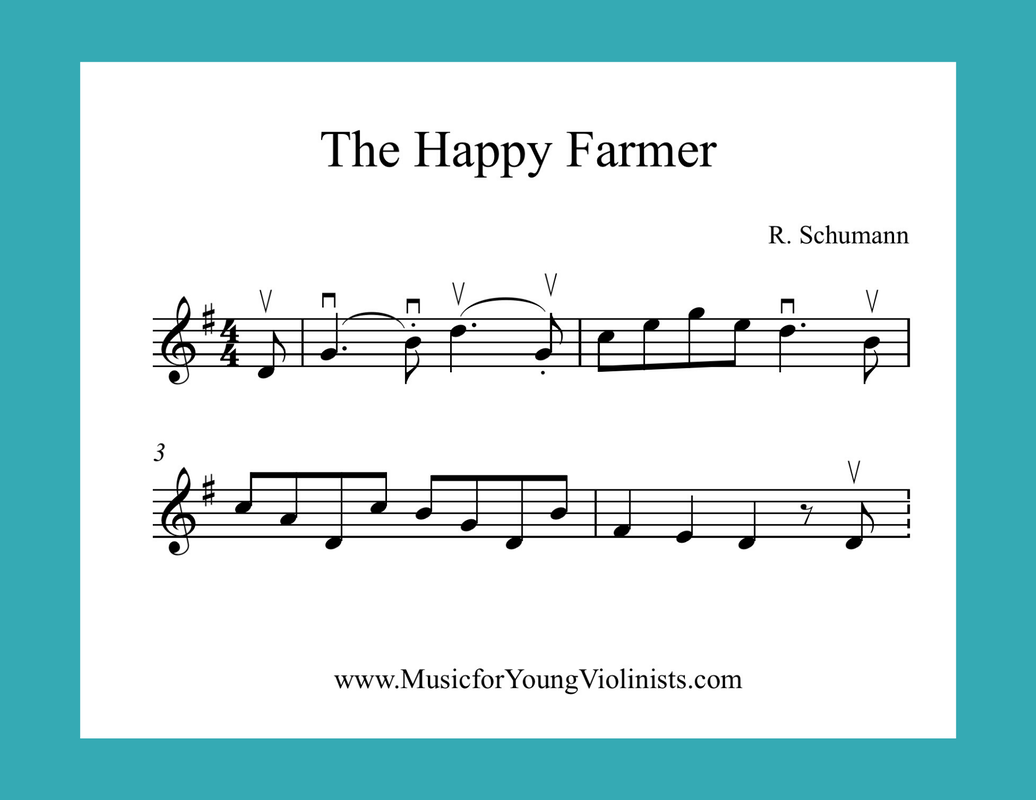
For both versions, you need to go at a steady pace, a metronome may help you with this. For arm vibrato, the motion will start from the elbow – back and forth to a proper violin position. For the wrist vibrato motion, all you do is go back and forth, in a steady motion, from your wrist up. Hold your shaker in the palm of your right hand. I’ve seen some do this exercise with a Tic Tac container. You can use a small container that fits in the palm of your hand that is filled with dry beans or rice or anything that rattles. OK, for this exercise it helps to have a cute egg shaker – but you really don’t need one.
#THE HAPPY FARMER VIOLIN HOW TO#
For a clear reference on how to do this drill, refer to the accompanying video that is posted below this article. You can do each motion of this exercise in sets of three or four. Your right hand will go at a faster but steady (tremolo like) motion while your left hand goes back and forth in a slower motion (up and down the pretend fingerboard).ĭon’t forget to do this whole routine with a left hand violin position. Last, you will do the same motion but with opposite hands. With your left arm, you will go back and forth as if you’re doing vibrato and at the same time your right arm will go back and forth at a very slow pace as if you’re doing a legato bowing motion. Now here’s where it gets complex for those who have never done this before. Then extend both arms outward and inward one after the other (your right hand will be doing a bow-like motion and your left hand is going up and down the fingerboard). Now begin by extending both arms (from the elbows) outward and inward at the same time. You will start by positioning your left and right hands in a violin-hold pose, wiggle your fingers. Which is what you do when you play vibrato. The goal with this exercise is to get your brain used to doing different motions with both hands at the same time. Start with quarter beats, then eighth beats, then 16th beats. Then you will rock your hands back and forth from your wrists to tap your fingers at a steady pace. Put your forearms together, you will cup your hands to touch your fingertips together.

This next exercise is a little specific to wrist vibrato, but it’s good for arm vibrato as well. Don’t forget to apply this exercise to your right hand as well. Start with the first finger, bend and flick down ward 3X and upward 3X. That means that your upper knuckle is loose enough. Your left fingertips should effortlessly flop up and down at the base of your top finger joint. With your right finger tips flick your left finger tip up and down. You do this by bending your finger at the middle joint – creating a 90 degree angle. The goal here is to release any tension and basically check if your fingers are gummy enough for vibrato.

This exercise is more of a “checkup” for your top finger joints. Take a look at the demonstration in the video below. This means do not press hard on the surface, don’t overextend when you straighten and don’t pop your knuckle up when you bend. The key here is to make sure your fingertip rolls are smooth and without any tension. It can be on your thumb, your arm, on a book, even on your steering wheel when you’re stuck in traffic. You can do this by bending and straightening your knuckle on any surface. The goal for this exercise is to get your finger’s top knuckle used to being loose and flexible. Steps forward in a consistent manner 1 Fingertip Rolls It will set you back in your violin journey and the goal here is to take Do not over work your muscles joints and tendons – you will risk injury if you do.īelieve me when I tell you, limit yourself when it comes to vibrato drills.Do them with a time limit to avoid over working your muscles, tendons and joints.It would really help my channel grow.įor all these exercises remember these redundant yet very important points: And if you have any questions please leave it in the comment box below the video.


Please take a little moment to press that subscribe and like button. Let me remind you that you can always subscribe to my YouTube channel or follow me on LBRY/Odysee to keep up with all my videos that are focused in self teaching violin through my own learning journey. The best part of these exercises is that you don’t need anything to do them with – not even a violin. All I have to work on now is speed (I’m curently vibrating at 114 BPM comfortably) and application. Some of these exercises I still do to this day – even though I’m in the advance stages of unlocking my vibrato. It’s especially good for novices and beginners that are not quite ready to start vibrato yet – but one day hope to do so. These pre-vibrato drills help with getting familiar with what is involved in producing vibrato. The first step I took to learn vibrato includes 5 pre-vibrato drills.


 0 kommentar(er)
0 kommentar(er)
